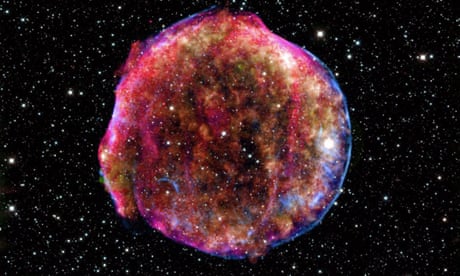- by foxnews
- 04 Apr 2025
Catch a failing star: the tense wait for a supernova
Catch a failing star: the tense wait for a supernova
- by theguardian
- 02 May 2022
- in news

If Stephen Smartt gets lucky, he may one day receive a message that will give the astrophysicist an advance warning that one of the most extraordinary displays known to science is about to light up the night sky. Signals relayed by automated telescope arrays and underground detectors will reveal that a star in our galactic neighbourhood has just turned supernova.
A supernova occurs when a star destroys itself so completely it can outshine the combined light of an entire galaxy. In the last thousand years, only five have ever been visible to the naked eye. Ironically, all occurred before the invention of the telescope.
All that is left behind is a neutron sphere that is so dense a matchbox of it would weigh about 3bn tonnes. And if the original progenitor star that led to the supernova was particularly large, this neutron star will become so heavy it will form a black hole from which nothing can escape, not even light.
This is a core-collapse supernova and it can unleash more energy than our sun will release over its entire 10bn-year lifetime. If a star in our galaxy, too distant to be seen by the naked eye on Earth, becomes a supernova, it will suddenly shine so brilliantly it could be seen in daylight.
Scientists estimate that on average about 20 supernovae occur in a galaxy such as ours every thousand years. Yet only five have been observed in the last millennium. East Asian and Arabic records indicate there were supernovae in 1006, 1054 and 1181, while European documents recall ones that occurred in 1572 and 1604.
Astronomers have since observed supernovae in other galaxies and studied remnants of those that have occurred inside our galaxy. These include the glowing filaments of the Crab Nebula, the remains of the supernova that lit up night skies in 1054AD and which have since been spreading across space.
Galactic debris such as this reveals the enormous destruction that is unleashed by supernovae. Yet these stellar convulsions are also important engines of creation, scientists argue. Apart from spraying the cosmos with heavy elements on which life depends, they also play a key role in planet and star formation, says astrophysicist Cosimo Inserra of Cardiff University.
Earth has experienced at least five mass extinctions that have each eradicated thousands of species of animals, plants and sea creatures, and at least one of these was caused by an extraterrestrial agent: an asteroid that struck Earth at the end of the Cretaceous period 66m years ago, wiping out the dinosaurs.
Further proof for this idea is now being sought by scientists. They have discounted looking for iron-60 atoms because these decay too quickly to have survived the 360m years since the late Devonian mass extinction. Instead, they plan to seek out atoms of the isotope plutonium-244, which is also produced by supernovae and could survive for a few hundred million years. That research is now under way.
While scientists are confident a supernova will occur in 2022, whether it occurs in our galaxy is a different matter. In any given year, it is an unlikely prospect. On the other hand, one day it may just happen in our galactic neighbourhood. If it does, astronomers say they will be ready.
- by foxnews
- descember 09, 2016
'I traveled for an entire year for free - and saved $15K'
Hailey Learmonth explored Australia without paying rent, thanks to pet sitting. She saved $15,000, lived on farms, and embraced remote work to travel on a budget.
read more


